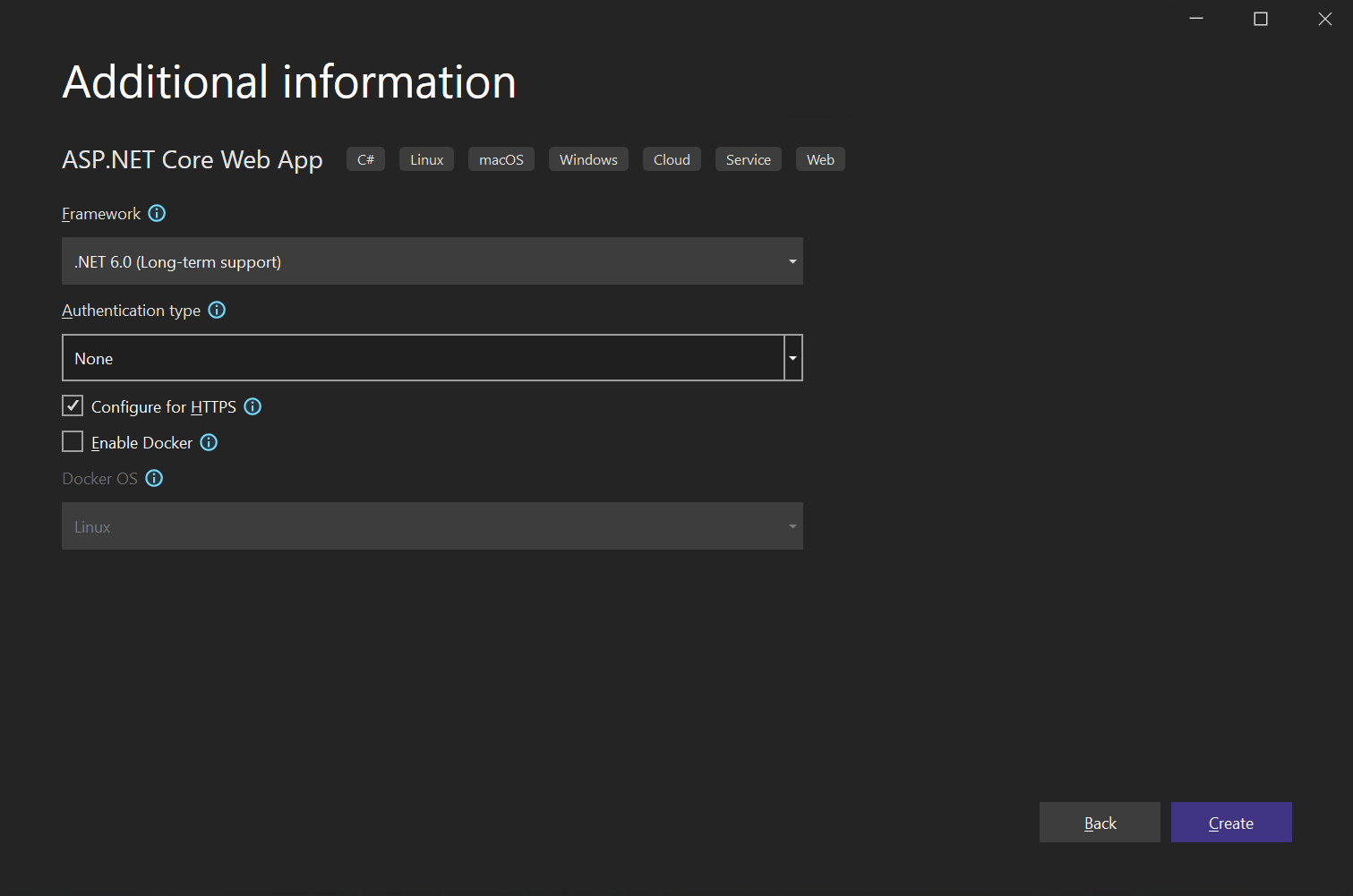Getting Started with an Empty ASP.NET Core MVC / Razor Pages Application
This tutorial explains how to start ABP from scratch with minimal dependencies. You generally want to start with the startup template.
Create a New Project
- Create a new AspNet Core Web Application with Visual Studio 2022 (17.0.0+):

- Configure your new project:

- Press the create button:

Install Volo.Abp.AspNetCore.Mvc Package
You can use the ABP CLI to install the Volo.Abp.AspNetCore.Mvc package to your project. Execute the following command in the folder of the .csproj file that you want to install the package on:
abp add-package Volo.Abp.AspNetCore.Mvc
If you haven't done it yet, you first need to install the ABP CLI. For other installation options, see the package description page.
Create the First ABP Module
ABP is a modular framework and it requires a startup (root) module class derived from AbpModule:
using Microsoft.AspNetCore.Builder;
using Microsoft.Extensions.Hosting;
using Volo.Abp;
using Volo.Abp.AspNetCore.Mvc;
using Volo.Abp.Modularity;
namespace BasicAspNetCoreApplication
{
[DependsOn(typeof(AbpAspNetCoreMvcModule))]
public class AppModule : AbpModule
{
public override void OnApplicationInitialization(ApplicationInitializationContext context)
{
var app = context.GetApplicationBuilder();
var env = context.GetEnvironment();
// Configure the HTTP request pipeline.
if (env.IsDevelopment())
{
app.UseExceptionHandler("/Error");
// The default HSTS value is 30 days. You may want to change this for production scenarios, see https://aka.ms/aspnetcore-hsts.
app.UseHsts();
}
app.UseHttpsRedirection();
app.UseStaticFiles();
app.UseRouting();
app.UseConfiguredEndpoints();
}
}
}
AppModule is a good name for the startup module for an application.
ABP packages define module classes and a module can depend on another. In the code above, the AppModule depends on the AbpAspNetCoreMvcModule (defined by the Volo.Abp.AspNetCore.Mvc package). It's common to add a DependsOn attribute after installing a new ABP NuGet package.
Instead of the Startup class, we are configuring an ASP.NET Core pipeline in this module class.
The Program Class
Next step is to modify the Program class to integrate to the ABP module system:
using BasicAspNetCoreApplication;
var builder = WebApplication.CreateBuilder(args);
await builder.AddApplicationAsync<AppModule>();
var app = builder.Build();
await app.InitializeApplicationAsync();
await app.RunAsync();
builder.AddApplicationAsync<AppModule>(); adds all services defined in all modules starting from the AppModule.
app.InitializeApplicationAsync() initializes and starts the application.
Run the Application!
That's all! Run the application, it will just work as expected.
Using Autofac as the Dependency Injection Framework
While ASP.NET Core's Dependency Injection (DI) system is fine for basic requirements, Autofac provides advanced features like Property Injection and Method Interception which are required by ABP to perform advanced application framework features.
Replacing ASP.NET Core's DI system by Autofac and integrating to ABP is pretty easy.
- Install Volo.Abp.Autofac package
Install-Package Volo.Abp.Autofac
- Add the
AbpAutofacModuleDependency
[DependsOn(typeof(AbpAspNetCoreMvcModule))]
[DependsOn(typeof(AbpAutofacModule))] //Add dependency to ABP Autofac module
public class AppModule : AbpModule
{
...
}
- Update
Program.csto use Autofac:
using BasicAspNetCoreApplication;
var builder = WebApplication.CreateBuilder(args);
builder.Host.UseAutofac(); //Add this line
await builder.AddApplicationAsync<AppModule>();
var app = builder.Build();
await app.InitializeApplicationAsync();
await app.RunAsync();
Source Code
Get source code of the sample project created in this tutorial from here.


